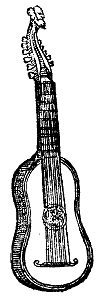 |
The Guitar and Vihuela |
The story of the guitar, like that of many plucked string instruments, is one of constant change. So many different instruments have been called "guitars" that it makes one wonder if the invention of a few new names wouldn't be a good idea. On the other hand, the naming of plucked stringed instruments in particular has always been a mess. A comparison of original sources will often show two completely different instruments with the same name, or conversely, two completely different names applied to very similar instruments. The first true guitar, with the characteristic hourglass body shape, appeared in the early sixteenth century. It seems to have largely displaced the older gittern, which disappeared at around the same time. The name "gittern" survived into the eighteenth century, then being used to describe a very similar instrument to the English Guitar, which wasn't a guitar at all, but a form of cittern. Both the late medieval gittern and the early guitar were sometimes called mandoras. See what I mean about names? The renaissance guitar was much smaller than the modern guitar (it's often mistaken for a ukelele), and had only four courses (three doubles and a single top). It also had a decorative rose in its soundhole, although guitar roses were generally constructed from several pierced layers of parchment, and then inserted, rather than being carved into the soundboard, as lute roses were. People like us, who play early guitars exclusively, often look at modern guitars and wonder why the rose has fallen out, until we remind ourselves that they're supposed to be like that. The renaissance guitar was capable of being fingered like a lute, and some simple fantasies were published for it. It doesn't have the bass range to be successful as a solo court instrument, though, and it was probably used more the way Diabolus use it, as a workhorse to provide strummed chords for ballads and dances. Used like this, it's a smashing little beastie, providing just the right balance between punch and tinkle, and its sound cuts like a knife through the thickest texture, or through the drones of a bagpipe or hurdy-gurdy. The renaissance guitar was played throughout Europe, but seems to have been especially popular in France. Spain, meanwhile, was playing something much larger, with six courses, called a Vihuela. This was guitar-shaped, and may have been modelled on the guitar, but it was tuned and played like the six-course lute that the rest of Europe was using. So you can call a vihuela a guitar-shaped lute, or a lute-tuned guitar. Or you can just call it a vihuela. During the sixteenth century, the guitar acquired a fifth course, which was a modest development compared with what happened to the lute. During the seventeenth century, the guitar gradually acquired a larger body, and became fashionable as a ladies' instrument. It stuck at five courses - the temptation to add extra necks, bass strings, ashtrays and microwave ovens seems to have been resisted by guitar makers. On the other hand, they went to town on the ornament for purchasers who could afford it. Guitars were inlaid with ivory and ebony in grotesque quantities, and their roses were often made of so many filigree layers that they formed impossibly complex inverted cones, reaching inwards almost to the back of the instrument. By the end of the century, the top course had changed from single to double, reflecting a new use as a continuo instrument, and the baroque guitar was born, complete with a new re-entrant tuning. Stradivarius (yes, that Stradivarius) made many guitars in the late seventeenth and early eighteenth centuries. One of his survives in the Ashmolean Museum, Oxford, and we're currently in the process of constructing a copy. It was only in the nineteenth century that the guitar became particularly associated with Spain. By then it was normally single strung, at higher tension, and a sixth course had been added. The Spanish classical guitar was possibly a successful amalgam of the guitar and the vihuela, via various intermediate forms and a few oddities that never worked. If you really want the latest information on the history of the guitar, and of all sorts of other European instruments such as vihuelas, citoles, gitterns, etc., you may like to get the lastest book on the subject. I haven't seen it myself, so I can't give you a direct recommendation, but if the sales info is correct, it looks like a pretty thorough bit of research. Unfortunately, it's only available in German at present. Title : "Quellenstudien zu europaischen
Zupfinstrumentenformen" Finally, a word or two from one of our sponsors : 
Electric guitars are just the latest machination of the guitar. But man are they fun to play. You could have your very own Gibson guitar. From the very first guitar, to the modern electric guitar the six strings have made music throughout time. |
 Diabolus Homepage |
 Look up another Instrument |
 Email for Diabolus |
